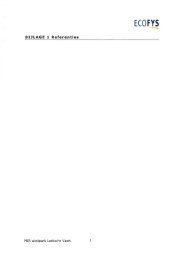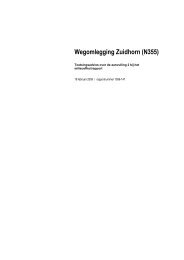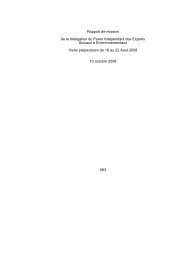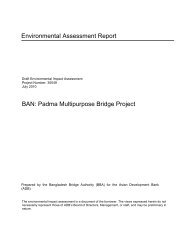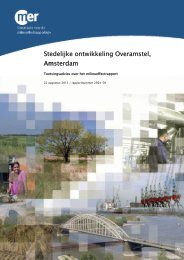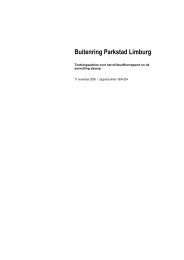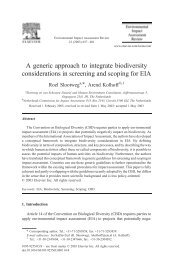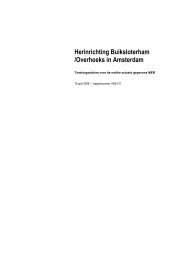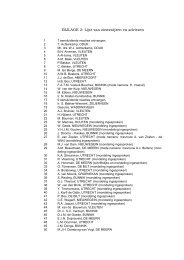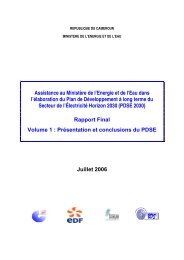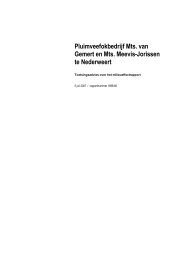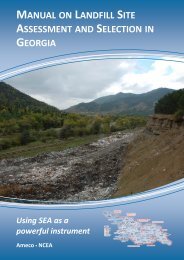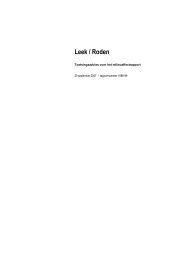Scoping Advice for the Dutch IWRM Support Programme Rwanda
Scoping Advice for the Dutch IWRM Support Programme Rwanda
Scoping Advice for the Dutch IWRM Support Programme Rwanda
Create successful ePaper yourself
Turn your PDF publications into a flip-book with our unique Google optimized e-Paper software.
Needs assessment per sector: USAID has produced a capacity needs assessment and staffing plan<strong>for</strong> <strong>the</strong> water department. Assess whe<strong>the</strong>r <strong>the</strong> needs assessment is complete: are all relevantsector departments and agencies included? If not, provide additional in<strong>for</strong>mation on <strong>IWRM</strong>capacity needs within <strong>the</strong>se departments or agencies.Central versus decentralised capacity needs: <strong>the</strong> needs assessment has been carried out be<strong>for</strong>e<strong>the</strong> Master Plan has defined <strong>the</strong> institutional arrangement <strong>for</strong> water management at catchmentlevel. Check consistency between needs assessment and <strong>the</strong> Master Plan; in case ofinconsistencies, define capacity development needs <strong>for</strong> proper implementation of <strong>the</strong>decentralised water management tasks.Coordination mechanisms: <strong>for</strong> a management in<strong>for</strong>mation system to be effective exchange ofin<strong>for</strong>mation between relevant parties in water management is fundamentally important. Of equalimportance is exchange of in<strong>for</strong>mation at catchment level. Catchment plans can only be made ifsector plans <strong>for</strong> each catchment are developed and assessed in a coordinated manner.The water law and Master Plan provide a possible coordination mechanism at central anddecentralised level through a water sector coordination committee and a catchment committee.Define:- <strong>the</strong> data exchange needs <strong>for</strong> an MIS to be effective;- <strong>the</strong> coordination needs <strong>for</strong> a catchment plan to become a document shared and owned by allrelevant stakeholders;- and to suggest alternative ways in which coordination and exchange mechanisms could beestablished within <strong>the</strong> boundaries set by <strong>the</strong> Water Law and Master Plan.Communication: In support of <strong>the</strong> coordination task as described above, explore ways ofimproving communication capacity at RWRD allowing <strong>for</strong> improved packaging and transfer ofin<strong>for</strong>mation to relevant parties and <strong>for</strong> development and implementation of a communicationstrategy As yet, no capacity exists at <strong>the</strong> RWRD to do or coordinate this.Learning by doing: following <strong>the</strong> recommendation 1 in section 2.4 regarding learning, investigateways <strong>for</strong> more effective transfer of knowledge and skills, including:- traditional training and teaching;- coaching, learning by doing, ‘on-<strong>the</strong>-job’ learning;- exchange (cross-visits, buddy/mentoring systems, consultants working at WD or WD staff atconsultants’ offices, etc).<strong>IWRM</strong> implementation at catchment levelCatchment planning approach. Assess <strong>the</strong> advantages and disadvantages of two alternativeapproaches to <strong>IWRM</strong> implementation at catchment level:- Blanket approach in which a catchment planning process is started simultaneously by <strong>the</strong>deployment of WD staff in key districts of each catchment. The approach is based on <strong>the</strong>notion that each catchment is unique, requiring a unique plan, but that <strong>the</strong> methodology tocome to a catchment plan is similar; mutual learning and exchange among WD staff enhances<strong>the</strong> process, or;30



